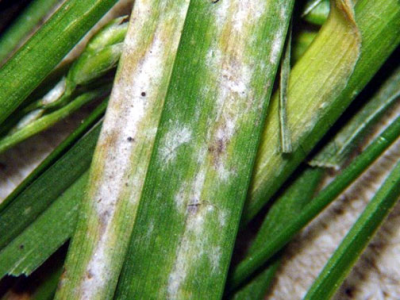Powdery mildew (Erysiphe graminis)
Powdery Mildew is a parasite plant of the family of fungi. The fungi live in the soil and on infected leaves for the whole year, obtaining from the lawn with the nutrients they need.Powdery Mildew, also called powdery mildew is a disease that attacks the plant and the leaves of the lawn.
Periods with low air circulation favor the disease.
The areas in the shade are particularly susceptible.
The disease is felt especially strong in the spring and fall with temperatures ranging from 15 to 22°C, however, develops in a range of temperatures ranging from 1 to 30 °C

HOW to RECOGNIZE The powdery MILDEW
The symptoms of powdery mildew or powdery Mildew include the following:
HOW to TREAT powdery MILDEW
The best treatment for powdery Mildew is to change some of the practices that are fostering the conditions for this disease to spread.
As long as the circumstances remain favourable for the powdery mildew will continue to infect the leaves of the grass and if this continues for long periods of time the damage will become permanent
Below you will find some tips on what to avoid and what to do to prevent powdery mildew:
The symptoms of powdery mildew or powdery Mildew include the following:
- The stages primitive of powdery mildew are recognized as isolated colonies of facilities gous whitish called mycelia that appear on the leaves
- The mycelia colonize and infect a large part of the leaf with sooty mold, powdery, whitish and grey
- The older leaves are affected more than younger leaves
- The leaves, most infected can turn brown yellow and then die. The colonies of powdery mildew, with time, darken
- The plants infected are weakened and become susceptible to other problems
HOW to TREAT powdery MILDEW
The best treatment for powdery Mildew is to change some of the practices that are fostering the conditions for this disease to spread.
As long as the circumstances remain favourable for the powdery mildew will continue to infect the leaves of the grass and if this continues for long periods of time the damage will become permanent
Below you will find some tips on what to avoid and what to do to prevent powdery mildew:
- Increases the circulation of air and penetration of light through the trees and shrubs through a good pruning
- Reseeding operations on the grass with the seed more tolerant to shady areas
- Increase the height of cuts, bringing the lawn to a height of 6-8 cm
- Water thoroughly and do not subject the lawn to water stress
- Improves the drainage to increase water absorption to the root zone and increase air circulation. A good aeration is recommended for this purpose
- Do not water at night. The water that remains on the lawn the night favours the spread of the disease
- Provide the right amount of manure and avoid excess nitrogen, which favour the spread of the disease. A granular fertilizer, slow release is capable of providing the right amount of nitrogen for a long period of time
